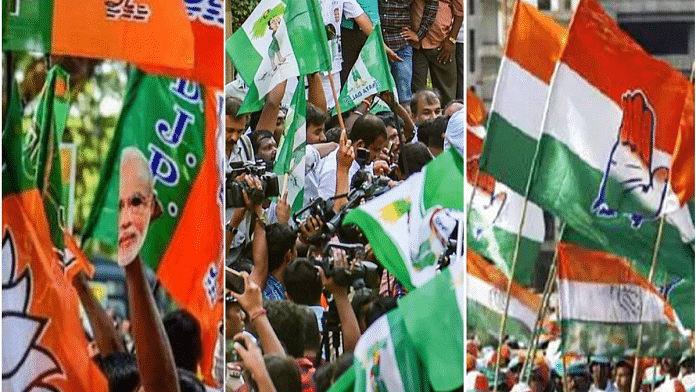Bengaluru: Karnataka votes on 10 May in what is possibly the most anticipated election before 2024 as the two national parties, the Bharatiya Janata Party (BJP) and the Congress, go head to head for a result that can set the tone for the general election.
The southern state cannot be viewed as a homogeneous unit but as a confluence of all its complexities including caste, unification history, and diverse regions that influence its society and politics in different ways.
Politics that works in northern Karnataka will not necessarily work in the southern districts. The same is true for coastal Karnataka and the central districts. The results mirror this uncertainty.
The Congress is the only party to secure a majority (in the year 2013) in the last four elections since 2000, while all others have been fractured verdicts and unstable coalitions. Siddaramaiah, the chief minister from 2013-2018, is among the handful CMs to have completed a full term in office.
The last time a party retained power was in 1985, when the Ramakrishna Hegde-led Janata Party got the mandate for another term. In fact, Hegde was sworn in three consecutive times as chief minister between January 1983 and September 1988, each time returning with a different coalition partner.
The BJP has ruled Karnataka for nine years and has had four leaders — Jagadish Shettar, D.V. Sadananda Gowda, Basavaraj Bommai and B.S. Yediyurappa — taking turns as chief minister. Yediyurappa was forced to step down four times (in 2007, 2011, 2018 and 2021) from the top post.
Diverse political landscape
Broadly, Karnataka is divided into Kittur-Karnataka (north western districts), Kalyana-Karnataka (north eastern districts), coastal and southern Karnataka. However, there are other sub-classifications like central Karnataka, Malnad, and Bengaluru (Urban) which account for 28 seats on its own. Bengaluru Rural is taken into account with south Karnataka and has 4 seats.
Also Read: ‘Left, right, touchables, others’ — how divisions among SCs are impacting Karnataka politics
Bengaluru
Bengaluru is taken as a unit in itself as the city alone accounts for 28 constituencies and the rural district has around 4 seats, some of which overlap the city’s outer areas. Home to over 1.3 crore people, Bengaluru is crucial for all political parties involved.
Of the total 26 seats (elections for two seats were held later), the BJP secured 11, the Congress 13 and Janata Dal (Secular), or the JD(S), got 2 in 2018. This was largely unchanged from the 2013 elections.
Bengaluru is considered a Vokkaliga-dominated city and the BJP has fared consistently well in the Lok Sabha elections from this district. The party has been ruling the city corporation (Bruhat Bengaluru Mahanagara Palike) since 2010 for two consecutive terms.
The civic election has not been held since September 2020, leaving the government responsible for its crumbling infrastructure, flooding and uncontrolled growth.
Old Mysuru & southern region
This region is what is known as the Vokkaliga belt and parts from where the JD(S) draws most of its strength. In 2018, the H.D.Devegowda-led party won 30 seats, including all 7 in the district of Mandya, the hotbed of Karnataka’s agricultural politics.
The bigger changes came in regions like Old Mysuru. Overall, there are 73 seats spread across 11 districts, including Bengaluru Rural, Mysuru, Mandya, Kolar, Ramanagara, Chikmagalur, Hassan and Kodagu.
In this region, the BJP won 21 seats in 2018 as against 6 in 2013. The Congress also won 21 seats here, 10 lower than what it managed in 2013. There were 2 Independents who won in 2018 as against 6 in 2013.
Coastal districts
Often referred to as the BJP’s Hindutva lab, coastal districts are possibly the only region in Karnataka where caste-based politics takes a backseat and is overshadowed by communal-brand politics.
In 2018, the BJP began its election campaign by highlighting how under Siddaramaiah, 23 Hindu workers were killed by ‘jihadis’ to seemingly bring in all caste groups under the larger umbrella of religion.
The BJP’s biggest gain came here as it won 16 of the total 19 in Dakshina Kannada, Udupi and Uttara Kannada — 13 more than in 2013. The Congress managed only 3 as against 13 in 2013.
Kittur Karnataka (Mumbai-Karnataka)
Earlier known as Mumbai-Karnataka, the Kittur-Karnataka region is the BJP’s biggest bastion from where it draws most of its strength as Lingayats make up for one of the biggest groups in these parts. These six districts have a total of 50 seats.
The BJP won 30 in 2018 which is 17 more than what it did in 2013, while the Congress won just 17 as against 31 in the previous election. The JD(S) won just 2 seats, one more than the previous time. Only 1 independent registered a win here as against 5 in 2013 that includes the KJP and others.
Kalyana Karnataka (Hyderabad-Karnataka)
In the Kalyana-Karnataka region, home to one of India’s most backward districts, there are 41 seats in total. The BJP won 17 in 2018, up from 5 in 2013. The Congress clinched 20 seats as this region has a mix of backward classes, Kurubas, Lingayats and minorities as against 24 in the previous elections.
The JD(S) registered 4 wins in this region. In 2013, there were other parties like Karnataka Janata Paksha (KJP) and B. Sriramulu-led Badavara Shramikara Raitara Congress Party (BSRCP) and several others who contested independently.
Central districts
There are 13 seats in Chitradurga and Davangere, the two central districts. The BJP won 10 out of this in 2018 as against just 1 in 2013. The Congress managed to win just 3 seats from this region in 2013 as against 10 in the previous polls. The JD(S) had managed to win 1 in 2013 but none in 2018.
(Edited by Tony Rai)
Also Read: Turncoats, some new faces, dynasty: Decoding BJP Karnataka list that has incensed many leaders



